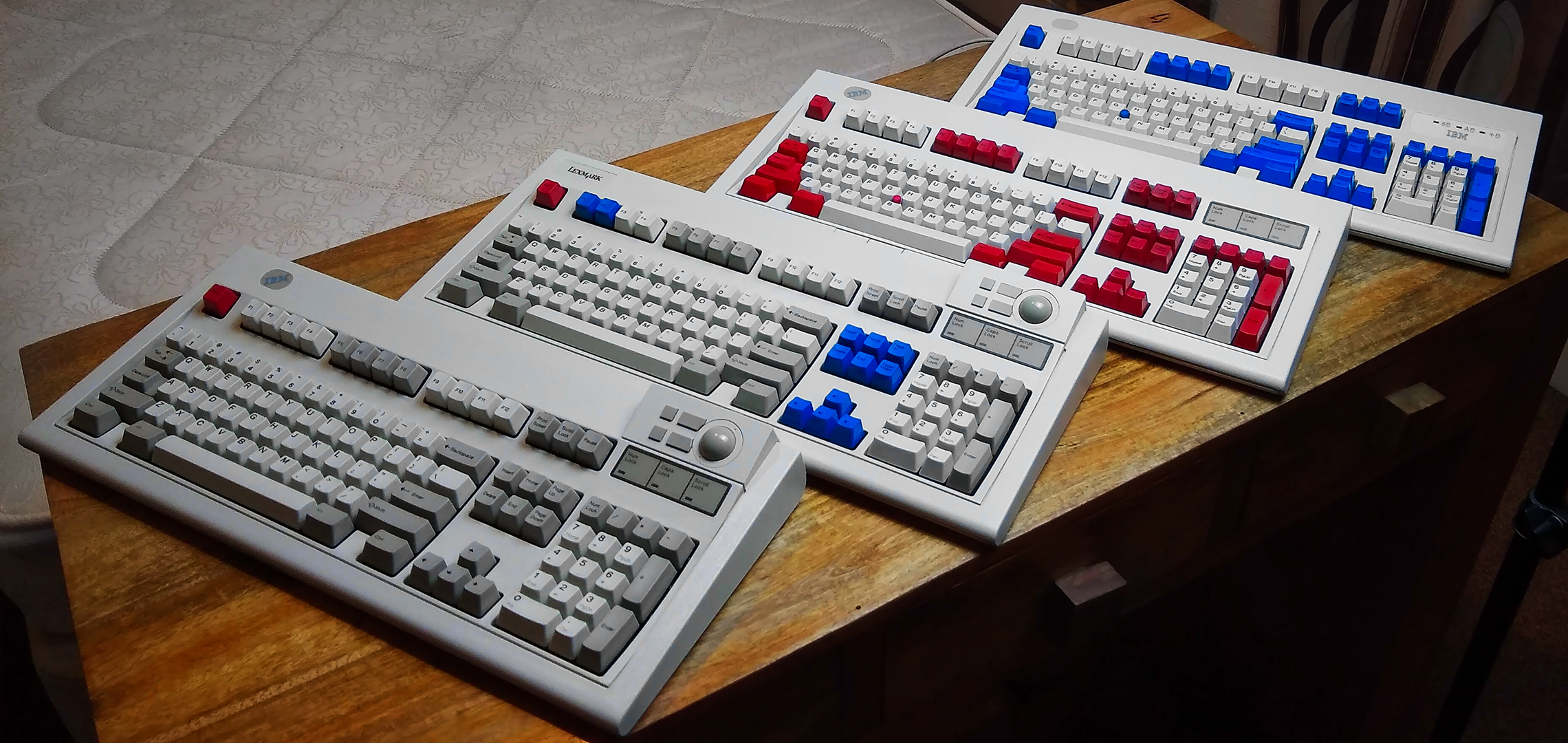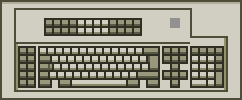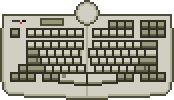¶ Summary
|
Model M Keyboards |
|
|---|---|

|
|
| Manufacturer(s) |
IBM (1984 - 1999) Lexmark (1991 - 1996) Key Tronic (1993 - 1998) Maxi Switch (1994 - 1998) Unicomp (1996 - present) Toshiba (2012 - present) |
| Branding |
IBM Lexmark Unicomp Dell General Electric etc. |
| Layout | Various layouts |
| Keyswitches | |
| Keycaps | Dye-sublimated PBT |
| Interface(s) | XT, AT, Proprietary RJ45 |
| Weight | See Info on Specific Model |
| Dimensions | See Info on Specific Model |
| Year(s) Produced | 1984 - present |
The Model M is a large family of computer keyboards created by IBM and later sustained by Lexmark, Unicomp, and Toshiba. The sole unifying principle of the family is the use of membrane sensing circuits; whilst membranes are common today, IBM's adoption of it contrasted the capacitive assemblies used by IBM previous two major families of keyboards. Other common well-known features found on Model Ms include membrane buckling spring switches and plastic riveted assemblies, although not all Model Ms featured either.
¶ History
The story of the Model M family begins in late 1983 when IBM patented the membrane buckling springs switch design invented by Edwin T. Coleman, III. The intent of the new membrane-driven design was to half the production cost of the buckling springs switch compared to Richard Hunter Harris' 1977 capacitive buckling springs design used in the Model F family keyboards.1 The first vessels of this switch design was the in fact typewriters; namely the IBM Wheelwriter 3, Wheelwriter 5 and Quietwriter 7, which were all released on 13th December 1984.2
The first discrete keyboard with this switch design was the IBM Enhanced Keyboard, which launched in June 1985 in the form of a terminal keyboard for the IBM 3161 ASCII Display Station (P/N 1386303).3 This was also officially designed “Model M” unlike the earlier Wheelwriter-family keyboard assemblies, and the PC-compatible versions of the Enhanced Keyboard such as P/N 1391401 cemented the reputation of the Model M and the status of the Enhanced Keyboard being the definitive member of the family. At the same time, the family started expanding with a 122-key terminal keyboard, 84/85-key tenkeyless keyboard, and various smaller keypad designs spawning between 1985 and 1987.
The 1990s were very eventful for the Model M family, with the early ‘90s seeing the formation and sale of IBM Information Products Corporation in August 1990 and March 1991 respectively to facilitate the divesture of IBM’s Lexington, KY and Boulder, CO typewriter and keyboard manufacturing operations.4 (IBM UK and Mexico still continued their own production). This resulted in the formation of Lexmark International, which IBM subsequently started marketing its products with IBM branding (including Model M keyboards)5 with a five-year contract to do so.The '90s saw the rise of numbered Model M variants, resulting in M1 through M15 (excluding M10, M12 and M14) being used as designations for unique keyboard designs sequentially from 1990 to 1994. The family also gained numerous members that did not use buckling springs or even full-travel switches, instead using technologies such as Quiet Touch-branded rubber domes (Enhanced Keyboard with Quiet Touch) or buckling rubber sleeves (M3, M4/M4-1, M6-1). Attempts to combine keyboard and pointing devices were also made, with keyboards featuring integrated trackballs (M5-1/M5-2) and TrackPoint isometric pointing sticks (M4-1, M6-1, M13) being released through 1993 and 1994.
When IBM's five-year contract with Lexmark was reaching its end, keyboard sales accounted for only 5% of Lexmark's gross profit and thus they made the decision in late 1995 to exit the keyboard market by April 1996. Assets related to buckling springs and Quiet Touch Model M keyboard production such as tooling were sold off to both IBM (presumably UK) and Maxi Switch, with the latter receiving the 1983 membrane buckling springs patent.6 Also in 1996, a group of former Lexmark (and in some cases former Lexmark and IBM) employees retired from the company to form Unicomp to continue to produce buckling springs and Quiet Touch Model Ms based on the last generation designed by IBM and Lexmark. Since tooling had already been sold off back to IBM and Maxi Switch by the time of Unicomp's founding, the fledging company spent the rest of the '90s recovering Model M tooling from other Model M factories under IBM and Maxi Switch to rebuild its tool base.7 By the turn of the millennium, Unicomp established a wide range of keyboards and the rest is history. Unicomp continued to produce buckling springs Model Ms for IBM as late as 20048, and 2012 was the last year IBM marketed any Model Ms in their name as it sold its IBM Retail Store Solutions division to Toshiba who then continued production of the Model M7 through M11 POS keyboards.
¶ Variants
These are the keyboards that were officially designated Model M by IBM or its later offshoot companies. Typically, the designation is given on the sticker label on the back of the keyboard or on the back of the internal assembly, or both. However, this designation may not be consistent for each factory - for example, IBM US, IBM Mexico, Lexmark and Unicomp usually ensured "Model M" was printed somewhere on the keyboard, whereas IBM UK rarely had the term printed on keyboards produced at the Greenock factory.
| Name | Model | Introduced | Icon9 |
|---|---|---|---|
| Enhanced Keyboard | M | 1985 |
|
| 122-key terminal keyboard (Model M) | M | 1985 |
|
| Alphanumeric POS Keyboard | M | 1986 |
|
| Space Saving Keyboard | M | 1987 |
|
| Screen Reader/2 Keypad | M | 1987 |
|
| 50-key financial keypad | M | 1987 |
|
| Selectric Touch Keyboard | M1/M2 | 1990 |
|
| L40SX Numeric Keypad | M3 | 1991 |
|
| Space Saver Keyboard | M4/M4-1 | 1993 |
|
| Trackball Keyboard | M5-1/M5-2 | 1993 |
|
| ThinkPad Keyboard Assembly | M6-1 | 1993 | |
| Retail POS Keyboard | M7 | 1993 |
|
| Retail POS Keyboard /w Display | M8 | 1993 |
|
| Retail ANPOS Keyboard | M9 | 1993 |
|
| Modifiable Layout Keyboard | M11 | 1993 |
|
| TrackPoint II Keyboard | M13 | 1994 |
|
| Adjustable Keyboard | M15 | 1994 |
|
| EnduraPro | M |
|
|
| Ultra Classic | M |
|
|
| New Model M | M | 2020 |
|
| Mini Model M | M | 2021 |
|
¶ Gallery
¶ References
- Google Patents - Rocking switch actuator for a low force membrane contact switch [accessed 2021-06-17]
- Hattiesburg American - The Blitz is On… IBM [accessed 2021-06-17]
- SharktasticA - P/N 1386303 [accessed 2021-06-17]
- Los Angeles Times - IBM Planning to Set Up New Subsidiary : Industry: A buyout firm will be the majority owner of its typewriter and keyboard operations [accessed 2021-06-17]
- IBM - Archives: 1990s - 1991 [accessed 2021-06-17]
- Plastic News - Lexmark exits keyboards, targets printers: firm to outsource more molding [accessed 2021-06-17]
- u/funkmon - I typed on the new Unicomp SSK. *Write-up of visit to Unicomp* [accessed 2021-06-17]
- SharktasticA - SNKB-M2004EP101 [accessed 2021-06-18]
- SharktasticA - Keyboard Icons Gallery [accessed 2021-06-17]



















